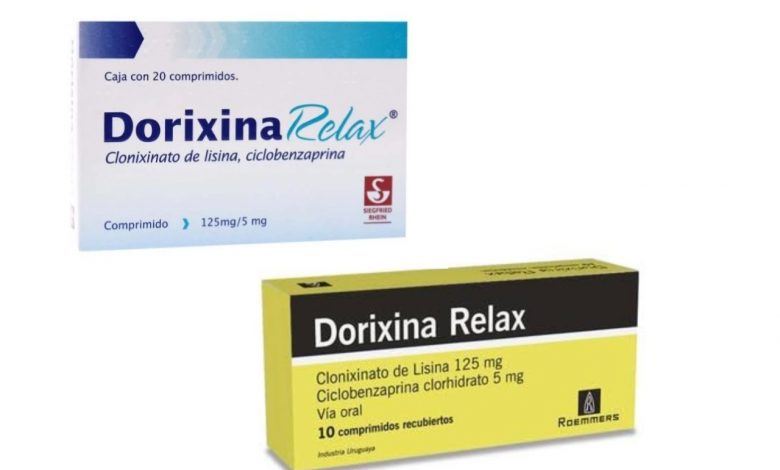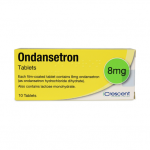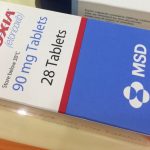How Dorixina Relax Works, Uses, Dosage, Side Effects, Interaction

What is Dorixina Relax?
Dorixina Relax is a combination medication that contains Lysine clonixinate and cyclobenzaprine as active ingredients. Dorixina Relax is used for the treatment of musculoskeletal pain, especially when associated with muscle spasms.
Musculoskeletal pain refers to pain in the muscles, bones, ligaments, tendons, and nerves. You can feel this pain in just one area of the body, such as your back. You can also have it throughout your body if you have a widespread condition like fibromyalgia.
The pain can range from mild to severe enough to interfere with your day-to-day life. It may start suddenly and be short-lived, which is called acute pain. Pain that lasts for more than 3 to 6 months is called chronic pain.
Each Dorixina Relax film-coated tablet contains 125 mg of lysine clonixinate and 5 mg of cyclobenzaprine HCl.
How it works
Dorixina Relax contains lysine clonixinate an NSAID derived from nicotinic acid that has proven to be effective in various pain syndromes such as muscular pain. The medication also contains cyclobenzaprine which belongs to a class of medications called skeletal muscle relaxants. It works by acting in the brain and nervous system to allow the muscles to relax.
In combination, these two drugs work synergistically in Dorixina Relax to inhibit prostaglandin synthesis and relieve musculoskeletal pain associated with muscle spasms. The cyclobenzaprine component relieves skeletal muscle spasms of local origin without interfering with muscle function. Cyclobenzaprine relieves muscle spasms and reduces tonic somatic motor activity, influencing both gamma and alpha motor systems at the central nervous level.
Who should not take Dorixina Relax?
You should not take Dorixina Relax if:
- You have known hypersensitivity to Lysine clonixinate or Cyclobenzaprine. You have an active peptic ulcer or gastroduodenal hemorrhage.
- You are pregnant or breastfeeding.
- You are less than 15 years of age.
- You have a history of bronchospasms, nasal polyps, angioedema, or urticaria caused by the administration of acetylsalicylic acid (aspirin) or other NSAIDs.
- You are taking or have monoamine oxidase inhibitors (MAOI) within the last 2 weeks.
- You recently suffered an acute myocardial infarction, heart failure, arrhythmia, heart block, or conduction disturbances.
- You suffer from hyperthyroidism.
How should I take Dorixina Relax?
The recommended dose of Dorixina Relax for adults is 1 tablet taken by mouth times daily at regular intervals, or according to pain intensity. Do not take this drug for more than 3 weeks without talking to your doctor. Follow the directions on your prescription label carefully, and ask your doctor or pharmacist to explain any part you do not understand. Take cyclobenzaprine exactly as directed. Do not take more or less of it or take it more often than prescribed by your doctor.
Remember to swallow the tablets whole, without chewing them, and with abundant liquid. The maximum daily dosage of Dorixina Relax is 6 tablets. Its continuous administration for over more than two or three weeks is not recommended.
What happens if I miss a dose of Dorixina Relax?
If you or someone misses a dose of Dorixina Relax, take the missed dose as soon as you can, but skip the missed dose if it is almost time for your next dose. Do not take two doses at one time.
What happens if I overdose?
If you or anyone accidentally took more than the recommended dose of Dorixina Relax, seek emergency medical attention or call the Poison Help line at 1-800-222-1222. An overdose of Dorixina Relax can be fatal. Overdose symptoms may include transient confusion, transient visual hallucinations, excitement, hyperreflexia, muscle rigidity, vomiting, hyperpyrexia, hypothermia, tachycardia, heart block, or congestive heart failure. In addition to the already mentioned adverse events, also mydriasis, convulsions, severe hypotension, stupor, and coma may occur.
What are the side effects of Dorixina Relax?
Dorixina Relax may cause side effects. Tell your doctor if any of these symptoms are severe or do not go away:
• Blurred vision
• Insomnia
• Constipation
• Dizziness
• Dry mouth
• Dyspepsia
• Extreme tiredness
• Headache
• Heartburn
• Nausea
• Nervousness
• Unpleasant taste
• Malaise
If you experience any of the following symptoms, call your doctor immediately:
• Skin rash
• Hives
• Swelling of the face or tongue
• Difficulty breathing or swallowing
• Irregular or fast heart rate
• Chest pain
• Tachycardia
• Hypotension
• Palpitation
• Anorexia
• Vomiting
• Diarrhea,
• Abdominal pain
• Gastritis
• Abnormal liver function
• Cholestasis
• Tinnitus
• Urinary frequency or retention
Dorixina Relax may also cause anaphylaxis, angioedema, pruritus, facial edema or edema of the tongue, urticaria, rash; ataxia, vertigo, dysarthria, tremor, hypertonia, muscle spasms, convulsions, disorientation.
If you experience a serious side effect, you or your doctor may send a report to the Food and Drug Administration’s (FDA) MedWatch Adverse Event Reporting program online (http://www.fda.gov/Safety/MedWatch) or by phone (1-800-332-1088).
What medication may interact with Dorixina Relax?
Several medications including supplements and vitamins may interact with Dorixina Relax. Do not take monoamine oxidase inhibitors (MAOIs) with Dorixina Relax. Doing so can cause dangerous effects on the body. Examples of these drugs include:
• selegiline
• rasagiline
• tranylcypromine
Taking Dorixina Relax with an MAOI or within 14 days of stopping an MAOI could increase your risk of serious side effects. These include seizures.
Taking Dorixina Relax with certain medications also raises your risk of side effects. This is because the amount of the medication in your body is increased. Examples of these drugs include:
• Benzodiazepines, such as triazolam, alprazolam, and midazolam. You may have more sedation and drowsiness.
• Barbiturates, such as phenobarbital. You may have more sedation and drowsiness.
• Drugs used to treat depression. These include fluoxetine, venlafaxine, amitriptyline, or bupropion. You may be at a greater risk for serotonin syndrome.
• Anticholinergic drugs, such as tolterodine or oxybutynin. You may be at a greater risk for certain side effects. These include dry mouth or not being able to urinate.





